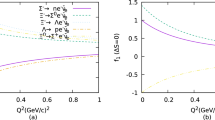Abstract
An expression for the decay rate Γ(π0 γγ) has been derived in the frameworkof the spinor strong interaction theory, a first-principles strong interaction theoryproposed some years ago as an alternative to low-energy QCD. The startingpoint is the SO(3) gauge-invariant action for two quark mesons which has beensuccessful in accounting for confinement, π+ → μ+ ν, e+ν, and π0 e+ν, nonexistenceof the Higgs boson, and other low-energy mesonic phenomena. The quasi-four-quarkmeson equations developed for the decay of a vector meson into twopseudoscalar mesons V → PP has been taken over here to apply to P(π0) →VV(ρ+ ρ−) → γγ(plus π+ and π− which annihilate each other). This mechanismin principle agrees with that of the assumption of vector meson dominance inthe literature. It, together with the effect of form factors, arises naturally in theformalism and need not be assumed. Equations for the perturbed vector mesonwave functions cannot be simply solved and an assumption has been made toobtain an estimate of their magnitude. Together with a constant associated withthe strong coupling obtained earlier from V(ϕ) → PP(K+K−), the estimated decayrate is 19.2 eV, in order-of-magnitude agreement with data (7.74 eV).
Similar content being viewed by others
REFERENCES
Steinberger, J. (1949) Phys. Rev. 76, 1180.
Gell-Mann, M., Sharp, D., and Wagner, W. G. (1962). Phys. Rev. Lett. 8, 261.
van Royen, R., and Weisskopf, V. F. (1967). Nuovo Cim. A 50 617.
Sakurai, J. J. (1969). Currents and Mesons, University of Chicago Press.
Bergström, L. (1990). In Rare Decays of Light Mesons, Mayer, B., ed., Frontieres, p. 161.
Adler, S. L. (1969). Phys. Rev. 177, 2426; Bell, J. S., and Jackiw, R. (1969). Nuovo Cim.A 60, 47.
Guiasu, I., and Koniuk, R. (1993). Phys. Lett. B 314, 408.
Hoh, F. C. (1993). Int. J. Theor. Phys. 32, 1111.
Hoh, F. C. (1994). Int. J. Mod. Phys. A 9, 365.
Hoh, F. C. (1996). J. Phys. G 22, 85.
Hoh, F. C. (1997). Int. J. Theor. Phys. 36, 509.
Hoh, F. C. (1998). Int. J. Theor. Phys. 37, 1693.
Hoh, F. C. (1999). Int. J. Theor. Phys. 38, 2647.
Hoh, F. C. (1999). Int. J. Theor. Phys. 38, 2617; denoted by I.
Lee, T. D. (1981). Particle Physics and an Introduction to Field Theory, Harwood, Eqs. (22.30)–(22.33)
Author information
Authors and Affiliations
Rights and permissions
About this article
Cite this article
Hoh, F.C. π0 → γγ in the Spinor Strong Interaction Theory. International Journal of Theoretical Physics 39, 1069–1084 (2000). https://doi.org/10.1023/A:1003606609117
Issue Date:
DOI: https://doi.org/10.1023/A:1003606609117




